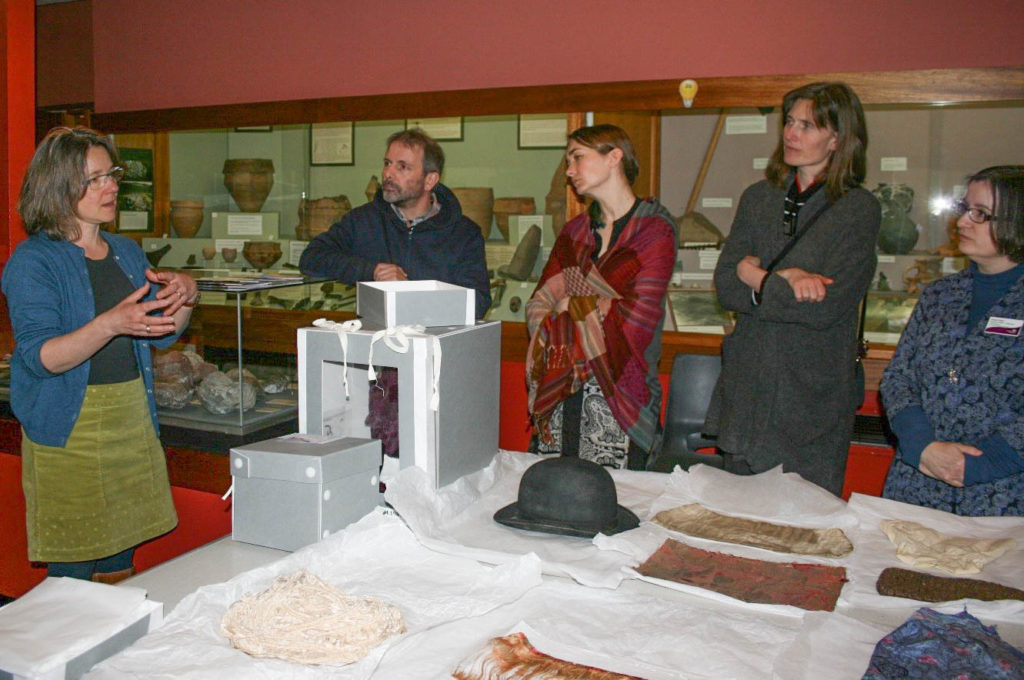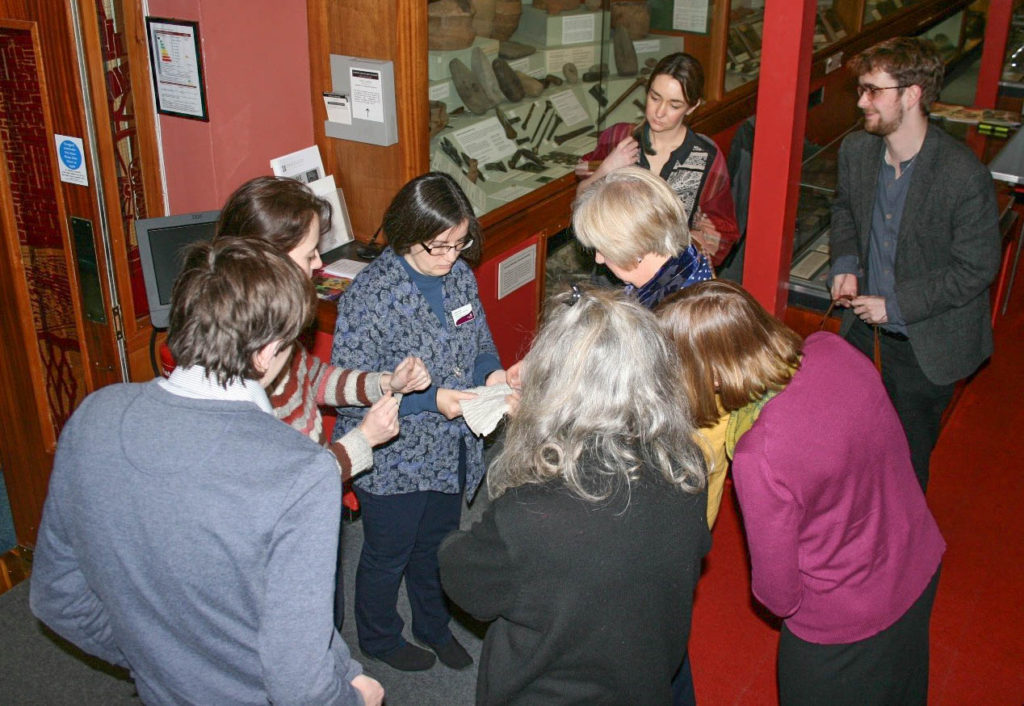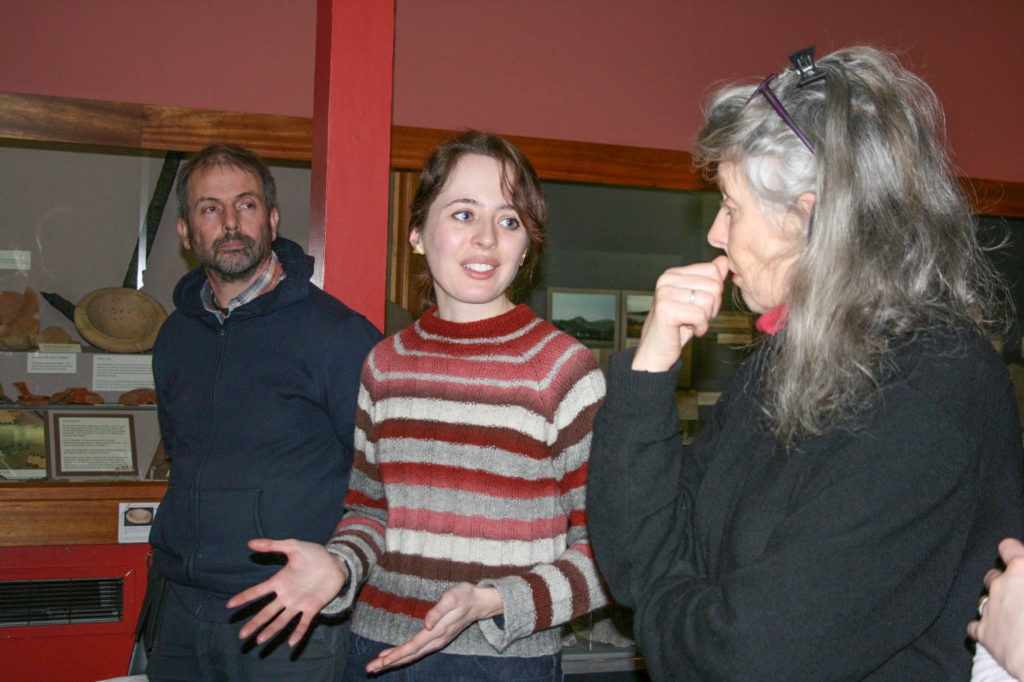
Earlier this month Karen Thompson, Lecturer in Textile Conservation, and Hannah Vickers, recent graduate of the MPhil Textile Conservation programme, presented a workshop and talk about conservation at Dumfries Museum to coincide with the display of the Mackenzie jacket at Dumfries Museum.
Conservation is one aspect of behind-the-scenes preparation for exhibitions and displays which is often not seen by the public, so being invited to Dumfries Museum to talk about the conservation of one of their most unusual objects was a fantastic opportunity to bring our work into the limelight. We gave an afternoon workshop about caring for textiles to museum staff and volunteers followed by an evening talk about the work of the Centre and conservation of Colin Mackenzie’s bloodstained jacket.
The afternoon workshop was part of the Dumfries and Galloway Museums Forum, which provides opportunities for different museum professionals to come together and share ideas and information. We took along a selection of objects from our Karen Finch Reference Collection to talk about some of the typical causes of damage to textiles and their short and long term effects in order to demonstrate why pest monitoring, control of environmental conditions such as temperature, humidity and light are so important. We also discussed some of the conservation treatments and storage solutions that the MPhil Textile Conservation students had carried out in previous years for Dumfries Museum. The challenges of safely storing museum objects was a focus for discussion. The often inevitable increase in size of an object before and after it is carefully repacked was a hot issue that was discussed as space is a problem for many museums, but the benefits were clearly appreciated.

Hannah also provided a personal talk about her research and conservation of the Mackenzie jacket, which provided a great way for the Forum to ask probing questions. The evening session provided an opportunity to talk in more detail about the work of a textile conservator and the decision-making involved in our work.

Hannah
I completed the support treatment and mounting of the bloodstained jacket last year for my final project. Visiting the museum was a great opportunity to give a talk as a conservation graduate and new professional, and to revisit the completed project.
An integral part of conservation is about tailoring the treatment, not just to meet the object’s needs in terms of stabilisation, but its future use and its context. I should have been prepared for seeing the jacket safely installed in the museum; even so, it was startling to finally see the garment in its display case, and wonderful to see it being examined and discussed by visitors. Talking about the project highlighted the value of the research and documentation that had informed the treatment decisions, as they had a second use as information for visitors. Initially, it was difficult to know how to tell the story of the treatment in a way that would be interesting to the general public. By tracing the history of the jacket and its owner through the stains and cuts of the violent attack they had both endured, it naturally leant itself to a forensic narrative (or a ‘Silent Witness’ style investigation, as the curator pointed out!). Following on from this, the conservation read like a medical treatment, with issues and their causes identified in order for a suitable remedy to be formulated.

Each talk prompted lively and varied discussions, with questions on both textile conservation – “Why do you use nylon net rather than a natural fibre?”, “Is it best to wear gloves when handling museum textiles?” and how to look after textiles at home – “How do you prevent or eliminate clothes moth infestations?” Equally, our audience offered new perspectives and insights into our work, for example, one gentleman suggested that the long cuts down the length of the jacket sleeves may have been made by Mackenzie’s doctors, to remove the garment more easily – a theory that makes a great deal of sense! All in all, the event proved to be a valuable opportunity for discussion and exchange.
Karen
The day really highlighted the value of the collaborative working partnership between the museum, the university and particularly for the students. Students on the programme are encouraged to collaborate with their clients both as they develop the conservation approach they plan to follow and during the progress of the object treatments but being involved in outreach provided the opportunity to see the whole process in the round. It is great for students and new graduates to see first hand the value of their work for the museum and also to engage with a wider audience. On a personal note, it is very rewarding to work with former graduates, our new professional colleagues, as they embark on their careers.

I am looking forward to more opportunities to share the work of the conservation students and talk about conservation more widely. The museum staff at Dumfries and Galloway Museums Service are planning an exhibition on conservation in the next couple of years featuring objects the students have conserved, which will be an exciting occasion to showcase conservation, the value of collaboration and involve the students in further public engagement and other outreach events.
Links to previous blog posts about the jacket history and treatment:

